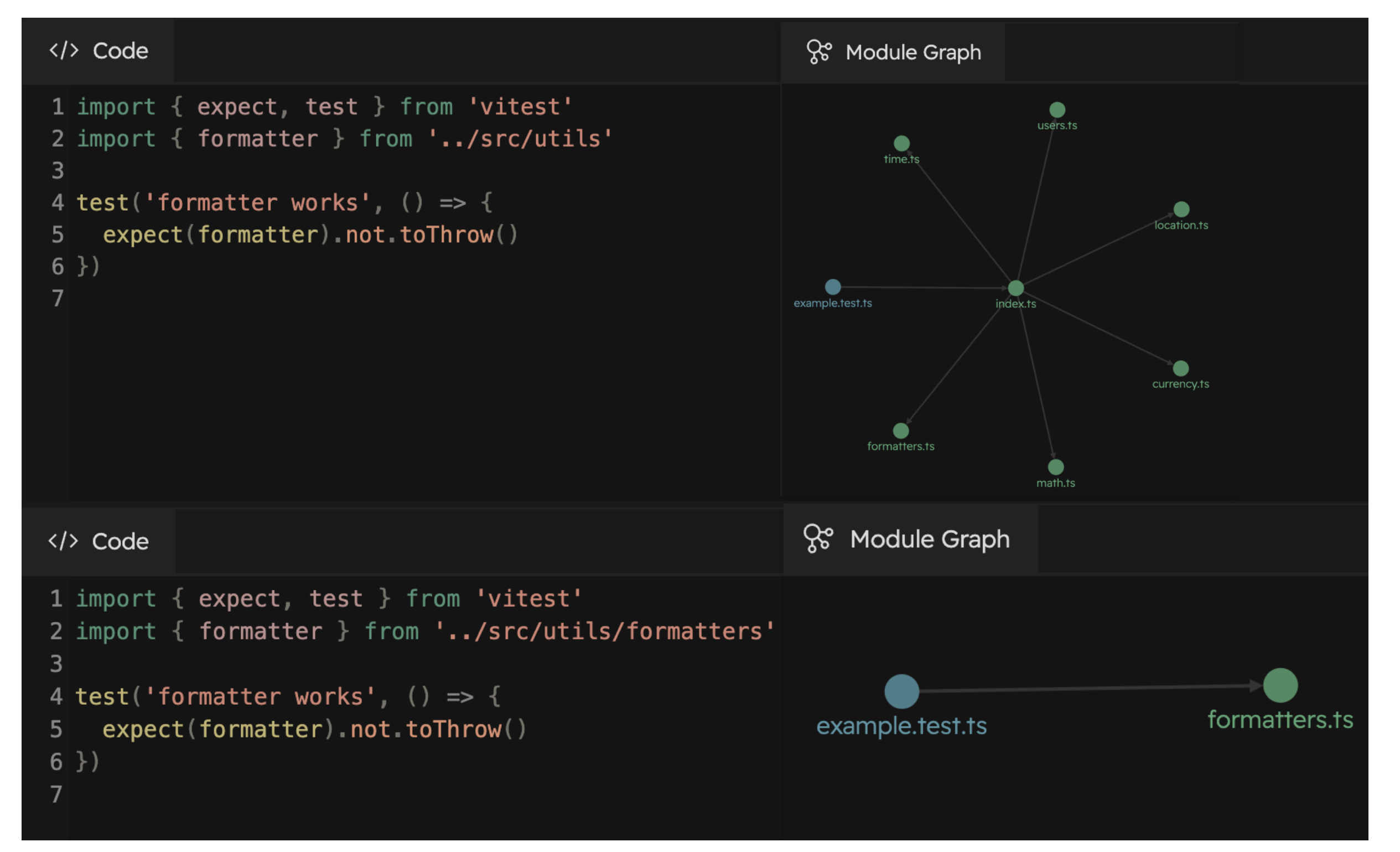測試效能分析
當您執行 Vitest 時,它會報告測試的多個時間指標:
bashRUN v2.1.1 /x/vitest/examples/profiling ✓ test/prime-number.test.ts (1) 4517ms ✓ generate prime number 4517ms Test Files 1 passed (1) Tests 1 passed (1) Start at 09:32:53 Duration 4.80s (transform 44ms, setup 0ms, collect 35ms, tests 4.52s, environment 0ms, prepare 81ms) # Time metrics ^^
- Transform (轉換):檔案轉換所花費的時間。請參閱檔案轉換。
- Setup (設定):執行
setupFiles所花費的時間。 - Collect (收集):收集測試檔案中所有測試案例所花費的時間。這包括匯入所有檔案依賴項所需的時間。
- Tests (測試):實際執行測試案例所花費的時間。
- Environment (環境):設定測試環境
environment所花費的時間,例如 JSDOM。 - Prepare (準備):Vitest 準備測試執行器所需的時間。
測試執行器
如果您的測試執行時間過長,您可以產生測試執行器的效能分析報告。請參閱 NodeJS 文件以了解下列選項:
WARNING
由於 node:worker_threads 的限制,--prof 選項不適用於 pool: 'threads'。
若要將這些選項傳遞給 Vitest 的測試執行器,請在您的 Vitest 設定中定義 poolOptions.<pool>.execArgv:
import { defineConfig } from 'vitest/config';
export default defineConfig({
test: {
pool: 'forks',
poolOptions: {
forks: {
execArgv: [
'--cpu-prof',
'--cpu-prof-dir=test-runner-profile',
'--heap-prof',
'--heap-prof-dir=test-runner-profile',
],
// 若要產生單一效能分析檔
singleFork: true,
},
},
},
});import { defineConfig } from 'vitest/config';
export default defineConfig({
test: {
pool: 'threads',
poolOptions: {
threads: {
execArgv: [
'--cpu-prof',
'--cpu-prof-dir=test-runner-profile',
'--heap-prof',
'--heap-prof-dir=test-runner-profile',
],
// 若要產生單一效能分析檔
singleThread: true,
},
},
},
});測試執行完成後,應該會產生 test-runner-profile/*.cpuprofile 和 test-runner-profile/*.heapprofile 檔案。請參閱檢查效能分析記錄以了解如何分析這些檔案的說明。
請參閱效能分析 | 範例。
主執行緒
分析主執行緒對於偵錯 Vitest 的 Vite 使用方式和 globalSetup 檔案很有用。 您的 Vite 外掛程式也會在此處執行。
為此,您需要將參數傳遞給執行 Vitest 的 Node.js 程序。
$ node --cpu-prof --cpu-prof-dir=main-profile ./node_modules/vitest/vitest.mjs --run
# ^^^^^^^^^^^^^^^^^^^^^^^^^^^^^^^^^^^^^^ ^^^^^
# NodeJS 參數 Vitest 參數測試執行後,應該會產生 main-profile/*.cpuprofile 檔案。請參閱檢查效能分析記錄以了解如何分析這些檔案的說明。
檔案轉換
如果您的測試轉換和收集時間過長,您可以使用 DEBUG=vite-node:* 環境變數來查看哪些檔案正在被 vite-node 轉換和執行。
$ DEBUG=vite-node:* vitest --run
RUN v2.1.1 /x/vitest/examples/profiling
vite-node:server:request /x/vitest/examples/profiling/global-setup.ts +0ms
vite-node:client:execute /x/vitest/examples/profiling/global-setup.ts +0ms
vite-node:server:request /x/vitest/examples/profiling/test/prime-number.test.ts +45ms
vite-node:client:execute /x/vitest/examples/profiling/test/prime-number.test.ts +26ms
vite-node:server:request /src/prime-number.ts +9ms
vite-node:client:execute /x/vitest/examples/profiling/src/prime-number.ts +9ms
vite-node:server:request /src/unnecessary-file.ts +6ms
vite-node:client:execute /x/vitest/examples/profiling/src/unnecessary-file.ts +4ms
...這種效能分析策略是識別由 barrel files (桶狀檔案) 引起的不必要轉換的有效方法。 如果這些日誌包含在測試執行時不應載入的檔案,則您的桶狀檔案可能不必要地匯入了其他檔案。
您也可以使用 Vitest UI 來排查由桶狀檔案引起的效能緩慢問題。 以下範例顯示了如何在不使用桶狀檔案的情況下匯入檔案,從而將轉換的檔案數量減少約 85%。
├── src
│ └── utils
│ ├── currency.ts
│ ├── formatters.ts <-- 待測試檔案
│ ├── index.ts
│ ├── location.ts
│ ├── math.ts
│ ├── time.ts
│ └── users.ts
├── test
│ └── formatters.test.ts
└── vitest.config.tsimport { expect, test } from 'vitest';
import { formatter } from '../src/utils';
import { formatter } from '../src/utils/formatters';
test('formatter works', () => {
expect(formatter).not.toThrow();
});
若要查看檔案如何轉換,您可以使用 VITE_NODE_DEBUG_DUMP 環境變數將轉換後的檔案寫入檔案系統中:
$ VITE_NODE_DEBUG_DUMP=true vitest --run
[vite-node] [debug] dump modules to /x/examples/profiling/.vite-node/dump
RUN v2.1.1 /x/vitest/examples/profiling
...
$ ls .vite-node/dump/
_x_examples_profiling_global-setup_ts-1292904907.js
_x_examples_profiling_test_prime-number_test_ts-1413378098.js
_src_prime-number_ts-525172412.js檢查效能分析記錄
您可以使用各種工具檢查 *.cpuprofile 和 *.heapprofile 的內容。請參閱以下清單以了解範例。
